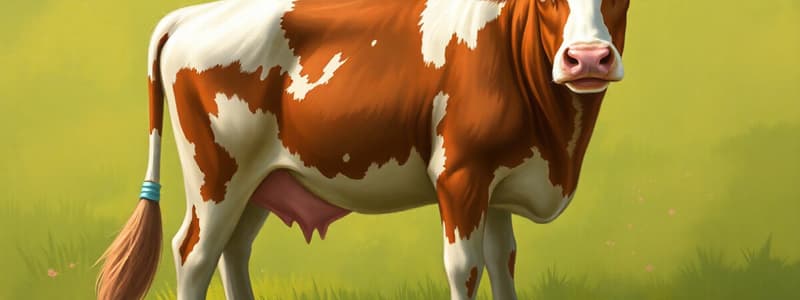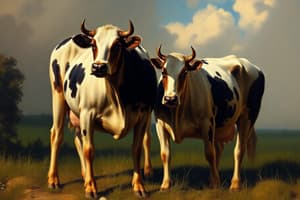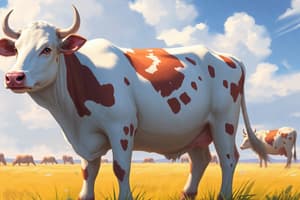Podcast
Questions and Answers
What is the primary focus of animal nutrition?
What is the primary focus of animal nutrition?
- Studying the aesthetics of animal feed.
- Developing new types of pet toys.
- Understanding the nutritional needs of domestic, zoo, and wild animals. (correct)
- Analyzing the social behavior of animals during feeding.
Which of the following is the most critical nutrient for animals?
Which of the following is the most critical nutrient for animals?
- Carbohydrates
- Proteins
- Water (correct)
- Fats
Which nutrient class provides the most concentrated source of energy?
Which nutrient class provides the most concentrated source of energy?
- Fats (correct)
- Water
- Minerals
- Vitamins
What type of animal has a simple, single-compartment stomach?
What type of animal has a simple, single-compartment stomach?
Which of the following is an example of a protein-rich concentrate?
Which of the following is an example of a protein-rich concentrate?
What is the purpose of grinding feed?
What is the purpose of grinding feed?
What is the first step in ration balancing?
What is the first step in ration balancing?
What is mastication?
What is mastication?
Which animal requires a high-fiber diet for hindgut fermentation?
Which animal requires a high-fiber diet for hindgut fermentation?
Which of these is a macro-mineral?
Which of these is a macro-mineral?
What is the function of the gizzard in avian species?
What is the function of the gizzard in avian species?
Which of the following is an example of a water-soluble vitamin?
Which of the following is an example of a water-soluble vitamin?
What is the term for non-nutritive substances added to diets to improve feed efficiency or animal health?
What is the term for non-nutritive substances added to diets to improve feed efficiency or animal health?
Which of the following is a common nutritional deficiency in dairy cattle related to calcium?
Which of the following is a common nutritional deficiency in dairy cattle related to calcium?
What does prehension refer to in the context of digestion?
What does prehension refer to in the context of digestion?
In proximate analysis, what does ether extract measure?
In proximate analysis, what does ether extract measure?
Which of the following nutrients is crucial for building and repairing tissues?
Which of the following nutrients is crucial for building and repairing tissues?
Which type of animal has a four-compartment stomach?
Which type of animal has a four-compartment stomach?
What is the purpose of pelleting feed?
What is the purpose of pelleting feed?
What are the main classifications of feedstuffs?
What are the main classifications of feedstuffs?
Flashcards
Animal Nutrition
Animal Nutrition
Study of nutritional needs of domestic animals, pets, and animals in zoos/wildlife.
Proper Animal Nutrition
Proper Animal Nutrition
Critical for growth, maintenance, reproduction, health, and productivity in animals.
Six Classes of Nutrients
Six Classes of Nutrients
Water, carbohydrates, fats, proteins, minerals, and vitamins.
Water
Water
Signup and view all the flashcards
Carbohydrates
Carbohydrates
Signup and view all the flashcards
Fats (Lipids)
Fats (Lipids)
Signup and view all the flashcards
Proteins
Proteins
Signup and view all the flashcards
Minerals
Minerals
Signup and view all the flashcards
Vitamins
Vitamins
Signup and view all the flashcards
Monogastric Animals
Monogastric Animals
Signup and view all the flashcards
Ruminant Animals
Ruminant Animals
Signup and view all the flashcards
Avian Digestive System
Avian Digestive System
Signup and view all the flashcards
Feedstuffs
Feedstuffs
Signup and view all the flashcards
Concentrates
Concentrates
Signup and view all the flashcards
Roughages
Roughages
Signup and view all the flashcards
Diet Formulation
Diet Formulation
Signup and view all the flashcards
Feed Additives
Feed Additives
Signup and view all the flashcards
Nutritional Deficiencies
Nutritional Deficiencies
Signup and view all the flashcards
Ration Balancing
Ration Balancing
Signup and view all the flashcards
Mastication
Mastication
Signup and view all the flashcards
Study Notes
- Animal nutrition is the study of the nutritional needs of domestic animals, pets and animals in zoos and wildlife, including the processes of how animals ingest, digest, absorb, transport, metabolize, and excrete nutrients.
- Proper animal nutrition is crucial for growth, maintenance, reproduction, health, and productivity.
- Nutrition affects overall animal well-being, impacting physical condition, coat quality, and disease resistance.
- Nutrient requirements vary based on species, age, physiological state (growth, pregnancy, lactation), activity level, and environmental conditions.
Six Classes of Nutrients
- Water is the most critical nutrient, involved in virtually every bodily function, including temperature regulation, nutrient transport, and waste excretion.
- Carbohydrates, primarily sourced from grains and forages, provide energy. They are broken down into glucose for immediate use or stored as glycogen.
- Fats (lipids) are a concentrated energy source, providing more energy per unit weight than carbohydrates or proteins. They are also essential for hormone production and cell membrane structure.
- Proteins are crucial for building and repairing tissues, producing enzymes and hormones, and supporting the immune system. They are composed of amino acids, some of which are essential and must be obtained from the diet.
- Minerals are inorganic substances necessary for various physiological functions, including bone formation, nerve function, and enzyme activity. Examples include calcium, phosphorus, potassium, and iron.
- Vitamins are organic compounds required in small amounts for specific metabolic processes. They are classified as either fat-soluble (A, D, E, K) or water-soluble (B vitamins, vitamin C).
Digestive Systems
- Monogastric animals, like pigs and poultry, have a simple stomach with a single compartment. Digestion begins in the stomach with the action of enzymes and hydrochloric acid, and continues in the small intestine.
- Ruminant animals, such as cattle, sheep, and goats, have a complex four-compartment stomach (rumen, reticulum, omasum, and abomasum). The rumen contains microbes that ferment plant matter, allowing the animal to derive energy from cellulose.
- Avian species (poultry) have a unique digestive system that includes a crop (for food storage), proventriculus (glandular stomach), and gizzard (muscular stomach for grinding food).
Feedstuffs and Diet Formulation
- Feedstuffs are the ingredients used in animal diets. They are broadly classified as concentrates (energy-rich or protein-rich) and roughages (high in fiber).
- Energy-rich concentrates include cereal grains like corn, wheat, and barley.
- Protein-rich concentrates include soybean meal, fish meal, and cottonseed meal.
- Roughages include pasture, hay, silage, and straw.
- Diet formulation involves determining the appropriate amounts of each feedstuff to meet the animal's specific nutrient requirements.
- Several methods can be used to formulate diets, including the Pearson square method, trial-and-error, and computer software programs.
- Feed additives are non-nutritive substances added to diets to improve feed efficiency, promote growth, or enhance animal health. Examples include antibiotics, probiotics, and enzymes.
Nutritional Disorders
- Nutritional deficiencies occur when an animal does not receive enough of a particular nutrient. Common deficiencies include vitamin and mineral deficiencies, which can lead to various health problems.
- Nutritional excesses can also be detrimental, leading to conditions like obesity, hypervitaminosis, and mineral toxicity.
- Metabolic disorders, such as milk fever in dairy cattle (calcium deficiency) and ketosis (energy deficiency), are often related to improper nutrition management.
Feed Processing
- Grinding increases the surface area of feed particles, improving digestibility.
- Pelleting involves compressing feed into uniform pellets, which reduces dustiness and improves handling.
- Extruding uses heat and pressure to cook feed, enhancing digestibility and altering texture.
Ration Balancing
- Ration balancing is the process of formulating a diet that meets an animal's specific nutrient requirements. This involves considering the animal's species, age, weight, physiological state, and activity level.
- The first step in ration balancing is to determine the animal's nutrient requirements using published tables or software programs.
- Next, the nutrient content of available feedstuffs must be determined using feed analysis.
- Finally, the feedstuffs are combined in the appropriate proportions to meet the animal's nutrient requirements.
Digestion Process
- Prehension: The act of seizing or grasping food.
- Mastication: The process of chewing, which breaks down food into smaller particles and mixes it with saliva.
- Deglutition: The act of swallowing.
- Chemical Digestion: Involves enzymes and acids breaking down food.
- Absorption: The process by which nutrients are taken up from the digestive tract into the bloodstream or lymphatic system.
- Excretion: The elimination of waste products from the body.
Importance of Water
- Water is the most essential nutrient for animals, comprising a large percentage of their body weight.
- Water is involved in numerous physiological processes, including nutrient transport, temperature regulation, waste excretion, and chemical reactions.
- Animals obtain water from drinking water, feed, and metabolic water (produced during metabolism).
- Water requirements vary based on species, age, physiological state, activity level, and environmental conditions.
Energy
- Energy is required for all bodily functions, including growth, maintenance, reproduction, and activity.
- Energy is typically measured in calories (cal) or joules (J).
- The energy value of feedstuffs is determined by measuring the amount of heat produced when they are burned.
- Net energy is the amount of energy available to the animal after accounting for losses due to digestion, metabolism, and excretion.
Proteins
- Proteins are complex molecules composed of amino acids.
- They are essential for building and repairing tissues, producing enzymes and hormones, and supporting the immune system.
- Animals require a specific balance of amino acids in their diet.
- Essential amino acids cannot be synthesized by the animal and must be obtained from the diet.
- Non-essential amino acids can be synthesized by the animal.
Minerals
- Minerals are inorganic substances required for various physiological functions.
- Macro-minerals are required in larger amounts (e.g., calcium, phosphorus, magnesium, potassium, sodium, chlorine, sulfur).
- Micro-minerals (trace minerals) are required in smaller amounts (e.g., iron, zinc, copper, manganese, iodine, selenium, cobalt).
- Mineral deficiencies or excesses can lead to various health problems.
Vitamins
- Vitamins are organic compounds required in small amounts for specific metabolic processes.
- Fat-soluble vitamins (A, D, E, K) are stored in the body and can accumulate to toxic levels.
- Water-soluble vitamins (B vitamins, vitamin C) are not stored in the body and must be consumed regularly.
Feed Analysis
- Proximate analysis is a standard method for determining the nutrient content of feedstuffs.
- It involves measuring the levels of moisture, crude protein, ether extract (fat), crude fiber, and ash (minerals).
- Other methods for feed analysis include amino acid analysis, mineral analysis, and vitamin analysis.
Animal-Specific Needs
- Beef Cattle: Focus on efficient forage utilization and weight gain.
- Dairy Cattle: High energy and protein requirements for milk production.
- Swine: Balanced amino acid profile is crucial for growth and muscle development.
- Poultry: High energy and protein needs for rapid growth and egg production.
- Horses: Fiber is essential for hindgut fermentation.
- Companion Animals (Dogs and Cats): Carnivorous diets with high protein and fat content are typical.
Studying That Suits You
Use AI to generate personalized quizzes and flashcards to suit your learning preferences.




